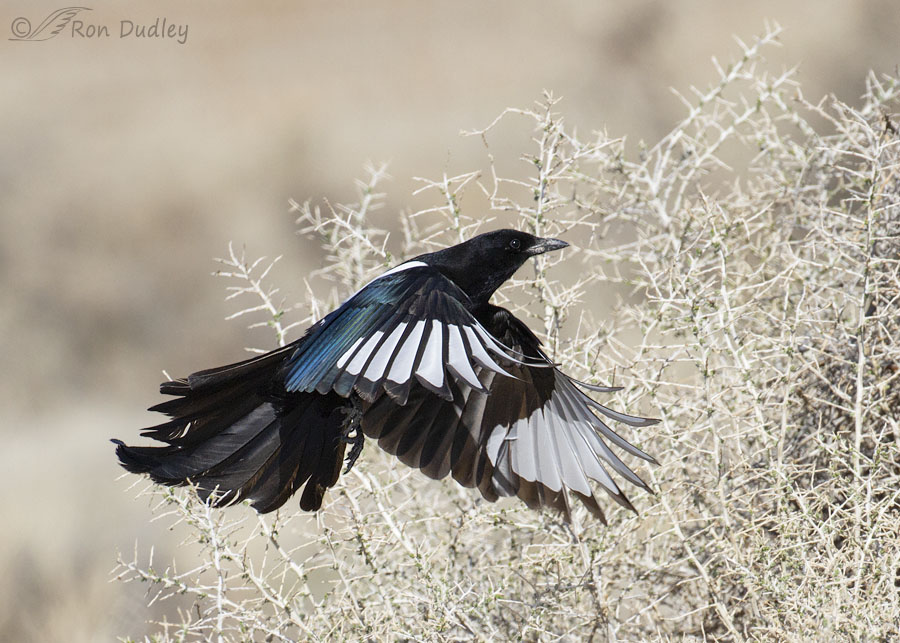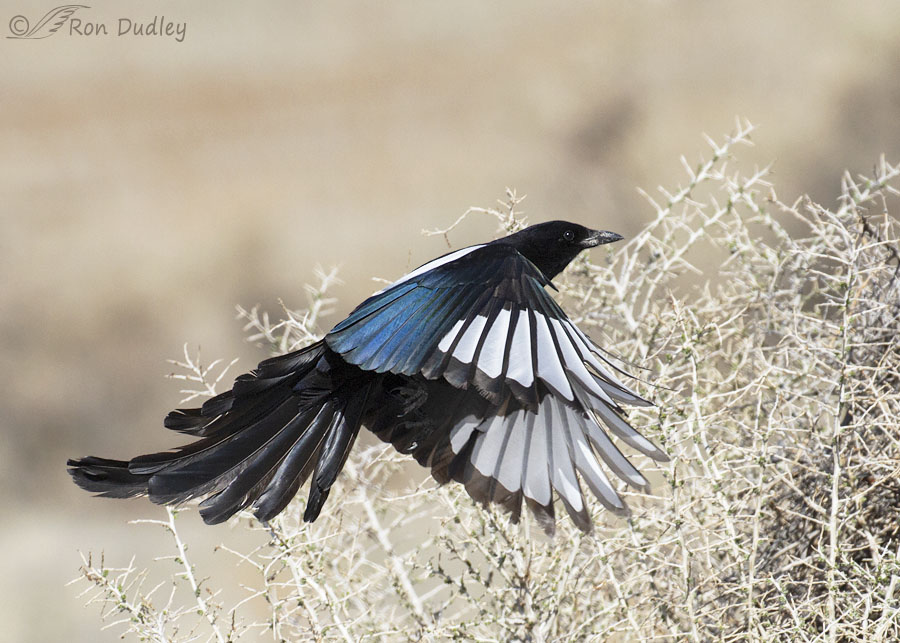Flying is a lot of work and sometimes it results in surprisingly little aerial progress.

1/4000, f/6.3, ISO 640, Canon 7D Mark II, Canon EF 100-400mm f/4.5-5.6L IS II USM @ 312mm, not baited, set up or called in
Yesterday morning I spent some time with a pair of Black-billed Magpies as they refurbished their nest buried in the interior of a still leafless greasewood bush. In this photo the left edge of their complex domed nest can be seen (sort of) as a slightly darker mass at the lower right edge of the frame.
Typical of magpie nests this one apparently has two entrances and one of them is out of frame just below the magpie in flight. This bird had used that entrance to deliver nesting material to the interior of the nest and then exited the same entrance. I caught ‘him’ in flight soon after he took off from the area of the entrance.

1/4000, f/6.3, ISO 640, Canon 7D Mark II, Canon EF 100-400mm f/4.5-5.6L IS II USM @ 312mm, not baited, set up or called in
This is the next shot in the burst, taken 1/10th of a second later.
After they’ve leafed out greasewoods can be beautiful in the settings of my bird photos but for obvious reasons I’m less fond of them when they’re still leafless. At this stage I think they’re unattractive and their bright, nearly white stems in combination with a mostly black bird are an incredibly difficult exposure for the photographer. The saving grace in both of these photos is the interesting flight postures and the good light I got on the contrasty magpie plumage that also produced some attractive blue iridescence.
But for me one of the most interesting things about this short series is the surprisingly small amount of aerial progress the magpie made between the first photo and the second. When the viewer picks out greasewood ‘landmarks’ behind the bird it becomes apparent that the magpie only traveled a little over 3″ in the tenth of a second between the two photos. Even though the magpie had recently taken off and he’s attempting to gain both forward and vertical progress I’m still surprised by the short distance he traveled in that amount of time.
Big deal you say, so what?
For me as a bird photographer who’s constantly trying to keep birds in the frame during and soon after explosive takeoffs this is critical information to be filed away and retrieved at a moment’s notice. Followers of Feathered Photography are well aware of how important it is to avoid clipping or cutting off body parts and when those long wings open quickly and unpredictably avoiding those ‘amputations’ is a formidable task. Accurately estimating speed and acceleration at takeoff and soon after is part of the formula for any success I may have.
As I’ve said ad nauseam in the past, in bird photography little things matter.
Ron
Note: To make the formula for success in this situation even more complex there was a stiff north breeze blowing in from my right when the magpie took off. Obviously that would tend to reduce his rate of acceleration.


I think the messy tail shows that he’s working his ass off! 😉
These are fantastic shots, especially with the high DOD. Thank you for the hint about how little progression the Magpie made between the two shots. I don’t think I would have noticed otherwise. You’re making me a better observer!
“You’re making me a better observer”
Thanks, Marty. Made my day, especially knowing that you were a skilled observer to start with.
❤️
Beautiful, Ron! I’m seeing an 1850s/1860s evening gown, complete with bustles and flounces and a train. No wonder it’s so hard to move!
“I’m seeing an 1850s/1860s evening gown, complete with bustles and flounces and a train”
Ha, now that’s a new one for me, Ellen. I like it.
Much as I love ‘our’ magpies, I would love to see yours too. Thank you for these stunning images of this diligent and hard working builder.
I wish we could experience each other’s magpies, EC.
What this bird lacks in upward momentum he more than makes up for with the artistry of this flight, the upturned wingtips, the gorgeous iridescence of the black/blue feathers and the white feathers that remind me of a stained- or leaded-glass window design, appearing “outlined” by the black. I even kinda like the lacy-like shrub and the beat-up tail feathers! 😬
Thanks, Chris. I have no problem with his beat-up tail but that bush is another matter.
I just hear , “Lift! I need lift!!!”
I wouldn’t doubt that that was what he was thinking.
I found the leafless aspect of the greasewood to be an advantage to your reader, in that being able to see the shadowed form inside all of those spiky branches and imagining the Magpie walking in at a lower level
helped me to appreciate the sheltering safety it offers–very interesting !
Kris, my dad used to challenge me to find anything that’s “bad” that didn’t have a good side. I seldom succeeded (although he could be pretty creative in coming up with the good side). What you said reminded me of him so thanks for the pleasant memory.
One of my Lakota friends said something similar….had a “positive” side and a lesson for us to learn…we only had to be open to them.
🙂
Talking with my mother in her last years I insisted she find something good to tell me (which is a long story). She sometimes struggled.
Beautiful bird and a very interesting shrub. I had to look up the info on the shrub as it does not grow here. Very interesting in regards to the age of this plant and then the ‘smell’ …’makes one remember rain…even in the hottest, driest times’. Reading things like this makes one wanting to travel to enjoy it!
Kathy, I think of greasewood as sort of a Cinderella plant. When the leaves come out it transforms into a strikingly lush and quite attractive bush, especially for a desert.
I’m a big fan of magpies, and since we don’t have them here your photos enable me to enjoy their magnificence.
A technical question: how did you figure it moved three inches? Pixel counting?
It’s only an estimation Lyle. I compare the distance the bird has moved between the two photos (based on the landmarks behind him) and compare that to to my estimation of the length of a particular part of the bird, in this case the estimated distance from the tip of the bill to the base of the neck.
That leafless greasewood bush is definitely unattractive, but it really shows off the striking colors of the Magpie. Not familiar with greasewood, but looking at it and seeing you use the term “spiky” I am wondering, do they fly through the entrances, or do they stop and walk through? It does look like they could lose some feathers if they fly through the entrances.
Always enjoy your Magpie photos. “Good morning Mr. Magpie.”
Everett, they have to walk through the entrances. The entrances enter the nest at weird angles, often from an angle below the chamber of the nest.
Appears it’s tail was running into the bush a bit in the 1st shot and tail feathers looks a bit ragged. “Hovering” is NOT something they’re known for here so that certainly is different. Glad you met the challenge and got the iridescence.😀
Judy, considering all the time they spend crawling around in that spiky bush I’m surprised his long tail looks as good as it does. Thanks.